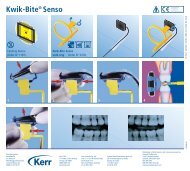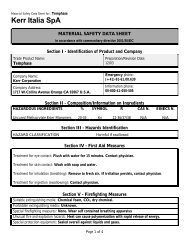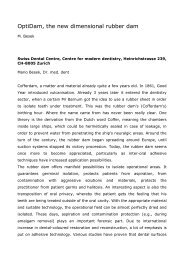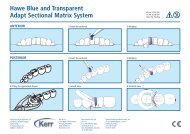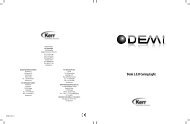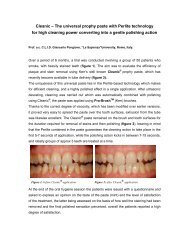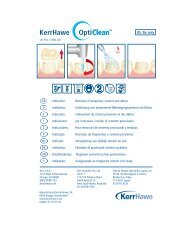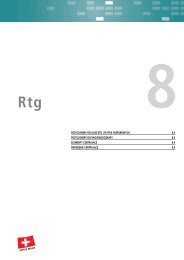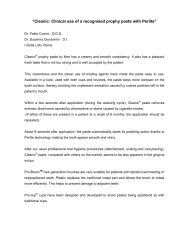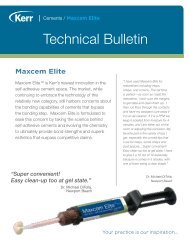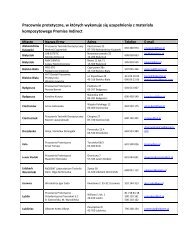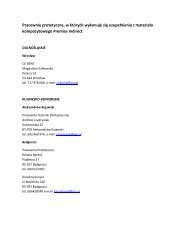Restorative Procedure - Kerr Hawe
Restorative Procedure - Kerr Hawe
Restorative Procedure - Kerr Hawe
Create successful ePaper yourself
Turn your PDF publications into a flip-book with our unique Google optimized e-Paper software.
systems. Although they were the first ones<br />
introduced, they are still widely used and have<br />
been shown to provide reliable bonding. Their<br />
main drawback seems to be technique sensitivity,<br />
since any deviation from the recommended<br />
procedure will result in inferior bonding.<br />
“Two-step” systems<br />
This group can be subdivided into two subgroups:<br />
i) they have a separate etch and have combined<br />
the priming and bonding steps. These systems<br />
are often referred to as “Single-bottle” systems.<br />
Similar problems found with the “Three-step”<br />
system can also be seen here.<br />
ii) etching and priming steps are combined together<br />
and bonding is separate. This is referred to as<br />
“Self-etching primers”. An acidic resin etches and<br />
infiltrates the dentine simultaneously. The tooth<br />
does not need to be rinsed which decreases<br />
the clinical application time and also reduces<br />
technique sensitivity by eliminating the need to<br />
maintain the dentine in a moist state.<br />
“One-bottle” or “All-in-one” systems<br />
This is when all steps are combined into one<br />
process. Their mode of action is similar to that of<br />
the “self-etching primers”, but the bonding resin is<br />
also incorporated. It is considered that these do<br />
not etch as effectively as the previous ones. They<br />
are the most recently introduced so limited clinical<br />
data is available.<br />
Bonding mechanism<br />
This micromechanical coupling of restorative<br />
materials to dentine, via an intermediate adhesive<br />
layer, is referred to as dentine bonding (3). The<br />
resin in the primer and bonding step penetrates<br />
the collapsed collagen fibrils (after demineralisation),<br />
and forms an interpenetrating network. This<br />
layer had been described extensively and in great<br />
detail (4, 5). The thickness of the hybrid layer<br />
ranges from less than 1 µm for the all-in-one<br />
systems to up to 5 µm for the conventional systems.<br />
The bond strength is not dependent on the<br />
thickness of the hybrid layer, as the self-etching<br />
priming materials have shown bond strengths<br />
greater than many other systems but exhibit a<br />
thin hybrid layer. The etching, rinsing and drying<br />
process cause the dentine to collapse due to the<br />
loss of the supporting hydroxyapatite structure.<br />
The collapsed state of collagen fibrils was hindering<br />
the successful diffusion of the resin monomers.<br />
To overcome this problem, two approaches were<br />
introduced. The first one is called “dry-bonding<br />
technique” and involves air-drying of dentine after<br />
etching and subsequent application of a waterbased<br />
primer that can re-expand the collapsed<br />
collagen (6, 7). The second one is the “wet bonding<br />
technique” in which the demineralized collagen is<br />
supported by residual water after washing (8). This<br />
allows the priming solution to diffuse throughout<br />
the collagen fibre network more successfully.<br />
However, when it comes to clinical practice, it is<br />
very difficult to find the correct balance of residual<br />
moisture. Excess water can be detrimental to<br />
bonding and these problems have been described<br />
as “overwetting phenomena” (9). Since the<br />
“dry-bonding technique” is considered to be<br />
significantly less technique sensitive, it should<br />
be preferred over the most difficult to standardize<br />
“wet bonding technique” (2).<br />
Relevant in-vitro bond strength studies can provide<br />
a useful indication of the prospective clinical<br />
success of a system. However, the highest level of<br />
evidence for comparing the efficiency of a bonding<br />
system is obtained from randomised clinical trials.<br />
Randomised clinical trials with elongated the<br />
treatment periods will be very useful in assessing<br />
both the effectiveness of a particular group and<br />
a particular method of application.<br />
References<br />
1. Nakabayashi N, Kojima K, Masuhara E. The promotion of adhesion by<br />
the infiltration of monomers into tooth substrates. J Biomed Mater Res<br />
1982;16:265-273.<br />
2. Van Landuyt K, De Munck J, Coutinho E, Peumans M, Lambrechts P,<br />
Van Meerbeek B. Bonding to Dentin: Smear Layer and the Process of<br />
Hybridization. In: Eliades G, Watts DC, Eliades T, editors. Dental Hard<br />
Tissues and Bonding Interfacial Phenomena and Related Properties Berlin:<br />
Springer; 2005. p. 89-122.<br />
3. Eick JD, Gwinnett AJ, Pashley DH, Robinson SJ. Current concepts on<br />
adhesion to dentin. Crit Rev Oral Biol Med 1997;8:306-335.<br />
4. Van Meerbeek B, Braem M, Lambrechts P, Vanherle G. Morphological<br />
characterization of the interface between resin and sclerotic dentine.<br />
J Dent Res 1994;22:141-146.<br />
5. Van Meerbeek B, Inokoshi S, Braem M, Lambrechts P, Vanherle G.<br />
Morphological aspects of the resin-dentin interdiffusion zone with<br />
different dentin adhesive systems. J Dent Res 1992;71:1530-1540.<br />
6. Finger WJ, Balkenhol M. Rewetting strategies for bonding to dry dentin<br />
with an acetone-based adhesive. J Adhes Dent 2000;2:51-56.<br />
7. Frankenberger R, Krämer N, Petschelt A. Technique sensitivity of dentin<br />
bonding: effect of application mistakes on bond strength and marginal<br />
adaptation. Oper Dent 2000;25:324-330.<br />
8. Kanca JI. Effect of resin primer solvents and surface wetness on resin<br />
composite bond strength to dentin. Am J Dent 1992;5:213-215.<br />
9. Tay FR, Gwinnett JA, Wei SH. Micromorphological spectrum from<br />
overdrying to overwetting acid-conditioned dentin in water-free acetonebased,<br />
single-bottle primer/adhesives. Dent Mater 1996;12:236-244.<br />
8<br />
Your practice is our inspiration.



